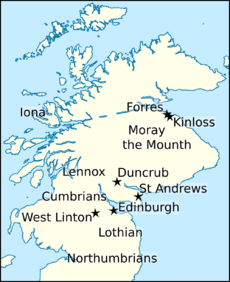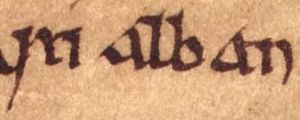Cuilén facts for kids
Quick facts for kids Cuilén mac Illuilb |
|
|---|---|
| King of Scots | |
| Reign | 967–971 |
| Predecessor | Dub mac Maíl Choluim |
| Successor | Amlaíb mac Illuilb and/or Cináed mac Maíl Choluim |
| Died | 971 |
| Burial | St Andrews |
| Issue | Custantín, Máel Coluim? |
| House | Alpin |
| Father | Illulb mac Custantín |
Cuilén (also known as Culén or Cuilean) was an early King of Alba (which is now Scotland). He ruled for a short time from 967 to 971.
Cuilén was the son of Illulb mac Custantín, who was also a King of Alba. He belonged to a powerful family called the Alpínid dynasty. This family often shared the kingship of Alba between two main branches.
After Cuilén's father died in 962, another king named Dub mac Maíl Choluim took the throne. Cuilén challenged Dub for the crown but lost a battle in 965. Dub was later forced out and killed in 966 or 967. It's not clear if Cuilén was involved in Dub's death.
After Dub's fall, Cuilén became the undisputed king. His reign was short and not much is known about it, except for his own death in 971. Sources say he and his brother, Eochaid, were killed by Britons. Some believe Cuilén's killer was Rhydderch ap Dyfnwal, whose daughter the king had taken. Rhydderch was likely an important leader, possibly even a king in the Cumbrian Kingdom of Strathclyde.
After Cuilén's death, his cousin Cináed mac Maíl Choluim became king. Cináed seems to have attacked the Cumbrians in revenge. Cuilén's brother, Amlaíb, also claimed the title of King of Alba for a short time before Cináed killed him in 977. Cuilén's son, Custantín, later became king after Cináed. Cuilén might have had another son named Máel Coluim.
Contents
Cuilén's Name and Family
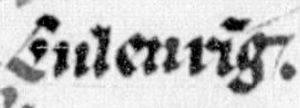
Cuilén was one of three sons of Illulb mac Custantín, King of Alba, who died in 962. His brothers were Eochaid (who died in 971) and Amlaíb (who died in 977).
Their father, Illulb, was the son of Custantín mac Áeda, King of Alba, who died in 952. Custantín had strong connections with the Scandinavian (Viking) rulers in Dublin. Some of Custantín's family members even had Scandinavian names. For example, Illulb's name might come from an Old Norse name. Amlaíb's name could also be a Gaelic version of the Old Norse name Óláfr. This suggests that their mother might have been from a Scandinavian family.
Old writings also hint at Viking influence in the Scottish court. One old text, the Chronicle of the Kings of Alba, calls Cuilén "Culenri[n]g". This might mean "Cuilén the King" in Gaelic. Some have suggested it could mean "ring-giver" in Old Norse, but it's more likely a simple title or a copying mistake.
The Alpínid Dynasty
| A simple family tree of two branches of the Alpínid dynasty: Clann Custantín meic Cináeda (blue) and Clann Áeda meic Cináeda (yellow). | |||||||||||||||||||||||||||||||||||||||||||||||||||||||||||||||||||||||||||||||||||||||||||||||||||||||||||||||||||||||||||||||||||||||||||||||||||||||||||||||||||||||||||||||||||||||||||||||||||||||||||||||||||||||||||||||||||||||||||||||||||||||||||||||||||||||||||||||||||||||||||||||||||||||||||||||||||||||||||||||||||||||||||||||||||||||||||||||||||||||||||||||||||||||||||||||||||||||||||||||||||||||||||||||||||||||||||||||||||||||||||||||||||||||||||||||
|---|---|---|---|---|---|---|---|---|---|---|---|---|---|---|---|---|---|---|---|---|---|---|---|---|---|---|---|---|---|---|---|---|---|---|---|---|---|---|---|---|---|---|---|---|---|---|---|---|---|---|---|---|---|---|---|---|---|---|---|---|---|---|---|---|---|---|---|---|---|---|---|---|---|---|---|---|---|---|---|---|---|---|---|---|---|---|---|---|---|---|---|---|---|---|---|---|---|---|---|---|---|---|---|---|---|---|---|---|---|---|---|---|---|---|---|---|---|---|---|---|---|---|---|---|---|---|---|---|---|---|---|---|---|---|---|---|---|---|---|---|---|---|---|---|---|---|---|---|---|---|---|---|---|---|---|---|---|---|---|---|---|---|---|---|---|---|---|---|---|---|---|---|---|---|---|---|---|---|---|---|---|---|---|---|---|---|---|---|---|---|---|---|---|---|---|---|---|---|---|---|---|---|---|---|---|---|---|---|---|---|---|---|---|---|---|---|---|---|---|---|---|---|---|---|---|---|---|---|---|---|---|---|---|---|---|---|---|---|---|---|---|---|---|---|---|---|---|---|---|---|---|---|---|---|---|---|---|---|---|---|---|---|---|---|---|---|---|---|---|---|---|---|---|---|---|---|---|---|---|---|---|---|---|---|---|---|---|---|---|---|---|---|---|---|---|---|---|---|---|---|---|---|---|---|---|---|---|---|---|---|---|---|---|---|---|---|---|---|---|---|---|---|---|---|---|---|---|---|---|---|---|---|---|---|---|---|---|---|---|---|---|---|---|---|---|---|---|---|---|---|---|---|---|---|---|---|---|---|---|---|---|---|---|---|---|---|---|---|---|---|---|---|---|---|---|---|---|---|---|---|---|---|---|---|---|---|---|---|---|---|---|---|---|---|---|---|---|---|---|---|---|---|---|---|---|---|---|---|---|---|---|---|---|---|---|---|---|---|---|---|---|---|---|---|---|---|---|---|---|---|---|---|---|---|---|---|---|---|---|---|---|---|---|---|---|---|---|---|---|---|---|---|---|---|---|---|---|---|---|---|---|---|---|
|
|||||||||||||||||||||||||||||||||||||||||||||||||||||||||||||||||||||||||||||||||||||||||||||||||||||||||||||||||||||||||||||||||||||||||||||||||||||||||||||||||||||||||||||||||||||||||||||||||||||||||||||||||||||||||||||||||||||||||||||||||||||||||||||||||||||||||||||||||||||||||||||||||||||||||||||||||||||||||||||||||||||||||||||||||||||||||||||||||||||||||||||||||||||||||||||||||||||||||||||||||||||||||||||||||||||||||||||||||||||||||||||||||||||||||||||||
Cuilén and his family were part of the ruling Alpínid dynasty. This family came from Cináed mac Ailpín, King of the Picts, who died in 858. They were successful because they managed to share the kingship among different family members.
For example, Cuilén's grandfather, from one branch of the family, became king after Domnall mac Causantín from another branch. After a long reign, he gave up the kingship to Domnall's son, Máel Coluim mac Domnaill. Cuilén's father then became king after Máel Coluim died in 954. He ruled until his own death in 962.
When Cuilén's father died, it was the last time Irish and Scottish records mention Viking attacks on the kingdom. The Viking Kingdom of York had fallen by the 950s. Viking warbands from Dublin also seemed to stop their overseas adventures. Unlike English kings, who faced Viking raids later, the kings of Alba had a period of peace. However, without outside threats, the Alpínid family began to fight among themselves for power.
Fighting for the Crown

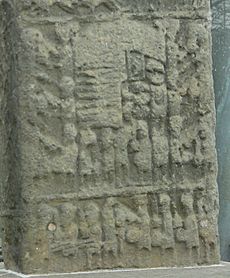
It's not completely clear who became king after Cuilén's father died. Some records say Dub became king. Other sources suggest that Dub and Cuilén might have shared the kingship for a while. This could mean that neither man was strong enough to take full control right away.
Even though Cuilén's father and Dub seemed to get along, conflicts broke out between the two family branches after Cuilén's father died.
The Chronicle of the Kings of Alba says that Dub spent much of his reign fighting Cuilén. They battled at a place called Dorsum Crup. Important leaders like Dúnchad, the Abbot of Dunkeld, and Dubdon of Atholl were killed in this battle in 965. Even though Dub won this battle, he was later forced out of the kingdom. The Annals of Ulster reports Dub's death in 967. Some king lists say Dub was killed at Forres.
Some people believe that the carvings on Sueno's Stone near Forres remember Dub's final defeat and death. It's possible that the story of his death was changed over time. The date of Dub's death suggests it happened after Cuilén had become king. It's not certain if Cuilén was directly responsible for Dub's death.
Cuilén's Reign and Death

Cuilén ruled as king from 966 to 971. His reign was quite peaceful, according to the records we have. His death in 971 is mentioned in several old texts. The Chronicle of the Kings of Alba says Cuilén and his brother, Eochaid, were killed by Britons. The Annals of Ulster also says Cuilén died fighting Britons. Another source, the Chronicon Scotorum, says Britons killed him inside a burning house.
The Chronicle of the Kings of Alba says Cuilén died at "Ybandonia". This might be Abington, but it's more likely to be Lothian or the Lennox. These areas were often places where Scots and Britons fought.
The Prophecy of Berchán tells a slightly different story. It says Cuilén died while "seeking a foreign land," possibly trying to collect taxes from the Cumbrians. The Chronicle of the Kings of Alba states that Cuilén's killer was Rhydderch ap Dyfnwal, who killed the king because Cuilén had taken his daughter. Other sources agree that Rhydderch killed Cuilén for this reason.

Rhydderch was likely the son of Dyfnwal ab Owain, King of Strathclyde. Even if Rhydderch wasn't a king himself, his ability to kill Cuilén suggests he was a very important and powerful person. It's possible that Cuilén was visiting the King of Strathclyde's court. His dramatic death suggests the Scots may have gone too far. Rhydderch might have been forced to burn his own home to kill Cuilén. Such events are known from other historical accounts.
The place name West Linton in Lothian was once called Lyntun Ruderic, which might refer to Rhydderch. This could be where Cuilén and Eochaid died. Cuilén's father had previously conquered Edinburgh and parts of Lothian. Cuilén's death in the same area might mean he was killed while trying to control this land. Rhydderch, the wronged father, might have used Cuilén's vulnerable position to get revenge for his daughter.

The Chronicle of the Kings of Alba says Dub's brother, Cináed mac Maíl Choluim, became the next King of Alba. However, Irish sources suggest that Cuilén's brother, Amlaíb, was king before Cináed killed him. It seems Cináed might have become king first, but Amlaíb managed to take the throne for a short time. Amlaíb's reign was brief, perhaps from 971 to 977. It's possible the kingship was shared between Amlaíb and Cináed until Amlaíb's death.
This constant change in kings shows that the family struggle between Cuilén and Dub continued with their brothers. Eochaid's death with Cuilén shows he was important. Amlaíb becoming king after Cuilén also suggests he played a big role in Cuilén's government.
One of Cináed's first actions as king was to invade the Kingdom of Strathclyde. This attack was probably revenge for Cuilén's killing. However, Cináed's invasion failed, showing that the Kingdom of Strathclyde was a strong power.
Burial and Children

Cuilén was likely buried at St Andrews, where his father was also buried. The Prophecy of Berchán says he was buried "above the edge of the wave," which seems to refer to St Andrews. Other sources sometimes say he was buried on Iona.
After about twenty years of peace within the Alpínid family, Cuilén's son, Custantín, became king in 995 after Cináed was killed.
Custantín had no known sons. He was the last of his family branch (Clann Áeda meic Cináeda) to be king. Cuilén might have had another son named Máel Coluim mac Cuiléin. This name appears in an old text called the Book of Deer, which lists people who gave money to the monastery of Deer. The name Cuilén was quite rare. However, it's hard to be sure if this Máel Coluim was Cuilén's son because the other names listed with him are not well-known historical figures. Still, the names listed right after him are famous kings. If Máel Coluim mac Cuiléin was indeed Cuilén's son, it could mean he represented his family branch during Cináed's reign.
Power Centers of the Alpínid Family
The way the Alpínid dynasty shared the kingship was similar to how powerful families in Ireland managed their rule. In Ireland, two branches of the Uí Néill family took turns being king because they were far apart. Neither branch could completely control the other.
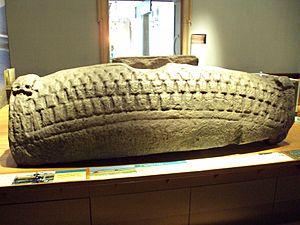
The similarities between the Scottish and Irish systems suggest that the two branches of the Alpínid family also had separate power bases. By the early 1000s, after Cuilén's family branch lost power, the other branch faced challenges from a family in Moray. This might mean that Cuilén's family (Clann Áeda meic Cináeda) was based north of the Mounth mountains in Moray. The other family branch (Clann Custantín meic Cináeda) might have been based in the south.
The fact that Máel Coluim mac Domnaill invaded Moray suggests that the southern branch was hostile to the people of the north. Also, both Máel Coluim and his son, Dub, were said to be killed by people from Moray. In contrast, there's no record of Cuilén's family fighting with people from Moray.
However, some records say Dub died at Forres, which is in the north. This could mean that the southern branch was actually based in the north. Also, Custantín mac Áeda retired to St Andrews, where his descendants, Illulb and Cuilén, were buried. Cuilén also died in the south, fighting the Cumbrians. This might suggest that Cuilén's family was based south of the Mounth. The deaths of the Abbot of Dunkeld and the leader of Atholl, who supported Cuilén against Dub, also point to a southern power base for Cuilén's family.
See also
 In Spanish: Culen de Escocia para niños
In Spanish: Culen de Escocia para niños


